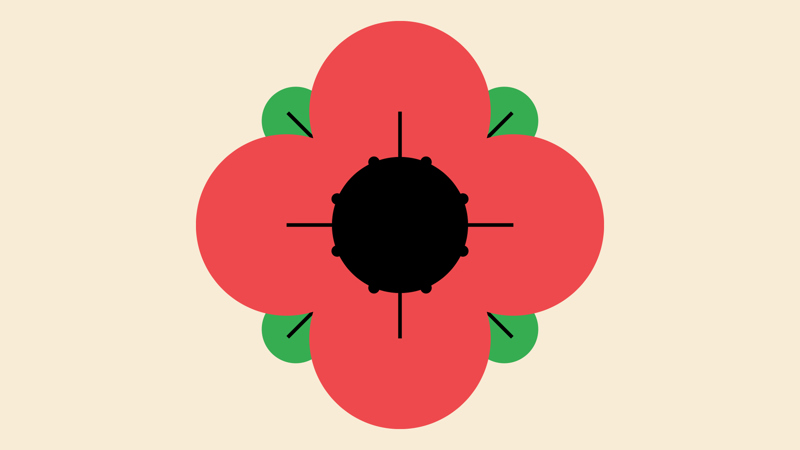
Sew a poppy wreath
You’ll need
- Scissors
- Coloured pens or pencils
- Red felt
- Green felt
- Needles
- Black thread
- Black buttons
Remembrance honours people who serve to defend our democratic freedom and way of life. We unite across faiths, cultures and backgrounds to remember the service and sacrifice of the Armed Forces community from the United Kingdom and the Commonwealth. We will remember them.
- We remember the sacrifice of the Armed Forces community from the United Kingdom and the Commonwealth.
- We pay tribute to the special contribution of families and of the emergency services.
- We acknowledge innocent civilians who’ve lost their lives in conflict and acts of terrorism.
Remembrance doesn’t glorify war and its symbol, the red poppy, is a sign of both Remembrance and hope for a peaceful future. Wearing a poppy isn’t compulsory but it’s greatly appreciated by those who it’s intended to support. When and how you choose to wear a poppy reflects your individual experiences and personal memories.
Remembrance unites people of all faiths, cultures and backgrounds, but it’s also deeply personal. It could mean wearing a poppy in November, joining with others in your community on a commemorative anniversary, or taking a moment on your own to pause and reflect. Everyone’s free to remember in their own way or to choose not to remember at all.
- Armistice Day is the 11 November. It marks the armistice agreement that bought an end to the fighting of the first world war.
- People pause at 11am on the 11 November to remember service and sacrifice past and present.
- The national service of Remembrance happens on the closest Sunday to 11 November, which is known as Remembrance Sunday. Each year people gather at the Cenotaph in London and other memorial sites.
- We call the whole period around these dates Remembrance. There are many ways to take part in Remembrance.
In 2022, the Royal British Legion remembers the Service of those who work to protect us and our ways of life. Whether in the Armed Forces, Emergency or Civilian Services, past or present, we remember who has served, how they served and why it’s important that we continue to remember them.
Before you begin
- Use the safety checklist to help you plan and risk assess your activity. Additional help to carry out your risk assessment, including examples can be found here. Don’t forget to make sure all young people and adults involved in the activity know how to take part safely.
- Make sure you’ll have enough adult helpers. You may need some parents and carers to help if you’re short on helpers.
Preparing the activity
- Decide whether you’ll use chairs and tables. If you do, set them out so there’s enough room for everyone to sit.
- Next to each chair (or spot on the floor), put a poppy, a poppy-sized piece of red felt, a small rectangle of green felt, a pair of scissors, a pen, a black button, and a needle and thread.
- Make the wreath – we’ve included some instructions below. You’ll probably want to do this in advance so you can focus on helping everyone during the session.
Run the activity
- Gather everyone in a circle.
- Chat about Remembrance. Talk about why it happens, what it means and how people usually mark the occasion. People’s ideas may include parades, wearing poppies, visiting the local war memorial or holding a two minutes silence.
- Explain that making a wreath of felt poppies is just one way we can choose to take part in Remembrance.
- Everyone should draw around their poppy’s flower on the red felt and cut it out.
- Next, draw around the poppy leaf on the green felt and cut it out.
- People should put their leaf under their poppy, so they overlap in the very middle.
- Put a black button on top of their poppy, so it's in the middle.
- An adult volunteer or young leader show everyone how to sew their button onto the middle of the poppy, so it holds all of the layers together. Everyone should copy them.
- When everyone's finished making their poppies, show everyone the wreath.
- It’s up to you whether you add the poppies during the session or between meetings.
- Everyone should spend some time chatting as a group about what they symbolise and why lots of people wear them around Remembrance.
- We’ve added some information in the Reflection below to help get you started.
How to make a wreath
- Cut out two circles of green felt the same size.
- Set the edges together, leaving at least one gap for stuffing. It’s usually easiest to leave a gap at the top and one at the bottom.
- Sew a border a few centimetres in. Sew this all the way around.
- Stuff the border of the wreath and sew up the gaps.
- Sew the Scouts logo into the middle of the wreath. You could also cut it out of felt, or even attach a (laminated) piece of paper.
Reflection
This activity gave everyone the chance to think a bit more about the poppy. Do people usually see lots of poppies around in November?
Did anyone already know what they meant and what they symbolised? Do people think it’s helpful to have a shared symbol like a poppy for important things like Remembrance?
In this activity, everyone thought about Remembrance and how it links to their lives. What did people find out about Remembrance? How did it make them feel? How are people going to take part in Remembrance this year?
Safety
All activities must be safely managed. You must complete a thorough risk assessment and take appropriate steps to reduce risk. Use the safety checklist to help you plan and risk assess your activity. Always get approval for the activity, and have suitable supervision and an InTouch process.
- Scissors
Supervise young people appropriately when they’re using scissors. Store all sharp objects securely, out of the reach of young people.
- Sharp objects
Teach young people how to use sharp objects safely. Supervise them appropriately throughout. Store all sharp objects securely, out of the reach of young people.
You could add some cardboard between the two felt circles before you sew it together to make the wreath stiffer.
You could write messages of remembrance (or the name of someone you’re remembering) on the poppy with a black pen.
You could also try out A pebble to remember or Paracord poppies for some alternative activities.
Let everyone know you’ll be doing some sewing before your meeting, so that anyone who wants to can practice beforehand.
If anyone struggles with fine motor skills, think about whether A pebble to remember would be a better choice for your group.
People could use needle threaders or bigger needles if this would make the activity work for them.
All Scout activities should be inclusive and accessible.
Why not check out the information on our heritage web pages to find out more about Scouts in the first world war? There are online exhibitions and other learning resources.
If you want to explore Remembrance further and create your own virtual Remembrance event, have a look at A Remembrance reflection.


